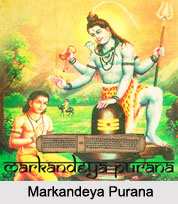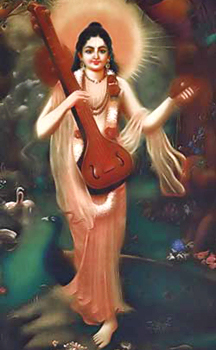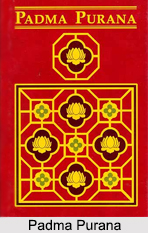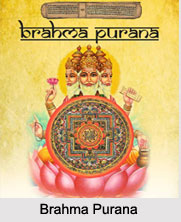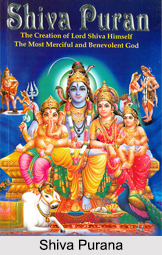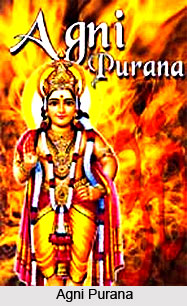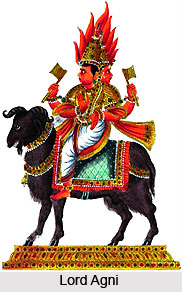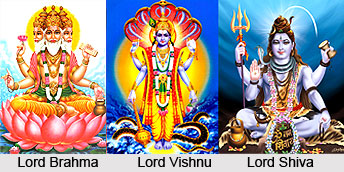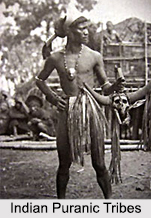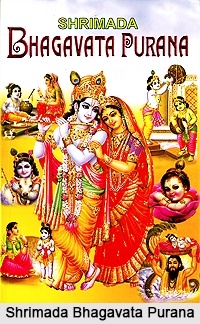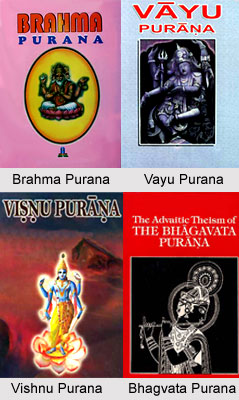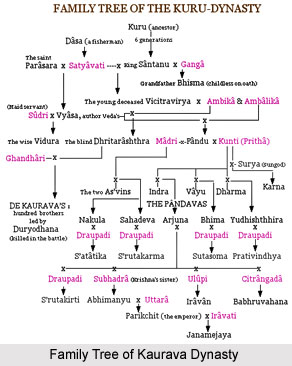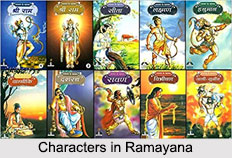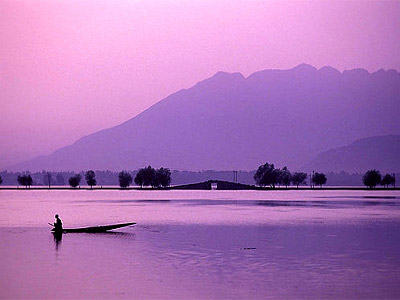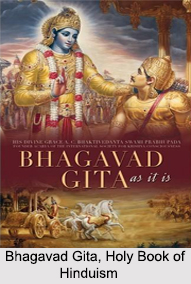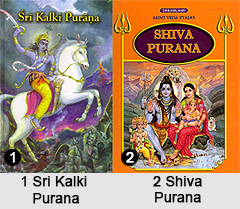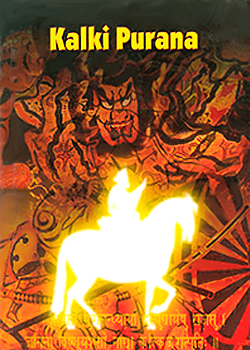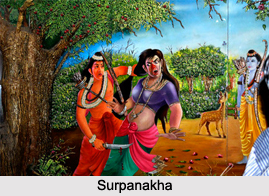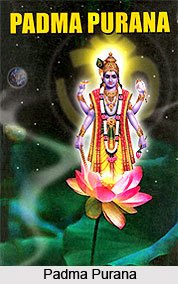 Khandas of Padma Purana are the five parts into which this ancient Indian text is divided. Khandas in Sanskrit means a partition, portion or part divided off from the whole. The following five Khandas are contained in the Padma Puranas- Book I, Srishti Khanda, i.e. section of the Creation; Book II, Bhumi Khanda i.e. section of the earth; Book III, Swarga Khanda, i.e. section of the heavens; Book IV, Patala Khanda, i.e. section of the nether world, and, Book V, Uttara Khanda, i.e. last section. A kind of appendix to the Uttara Khanda is formed by the Kriyayogasara, i.e. the essence of Yoga.
Khandas of Padma Purana are the five parts into which this ancient Indian text is divided. Khandas in Sanskrit means a partition, portion or part divided off from the whole. The following five Khandas are contained in the Padma Puranas- Book I, Srishti Khanda, i.e. section of the Creation; Book II, Bhumi Khanda i.e. section of the earth; Book III, Swarga Khanda, i.e. section of the heavens; Book IV, Patala Khanda, i.e. section of the nether world, and, Book V, Uttara Khanda, i.e. last section. A kind of appendix to the Uttara Khanda is formed by the Kriyayogasara, i.e. the essence of Yoga.
Srishti Khanda
Book I, Srishti Khanda, i.e. `section of the Creation,` commences with the usual introduction. Lomaharsana sends his son, the Suta Ugrasravas, to the Naimisa forest to recite the Puranas to the Rishis assembled there. At the request of Saunaka he tells them the Padma Purana, so-called after the lotus (Padma) in which the god Brahman appears at the creation. The Suta then reproduces the account of the creation as he has heard it from Brahman`s son Pulastya, The cosmological and cosmogonic myths are here too related similarly as in the other Puranas. But in this book, it is not Lord Vishnu who is assumed as the first cause, but the highest Brahman in the form of the personal god Brahman. Nevertheless, even this book is Vishnuite in character, and contains myths and legends for the glorification of the god Vishnu.
After the account of the Creation come the usual genealogies of the solar dynasty, into which a section about the Pitrs, the fathers of the human race and their cult by means of Sraddhas has been interwoven, and of the lunar dynasty down to the time of Lord Krishna. Myths are then told of the conflicts between gods and demons, followed by a chapter which is of interest from the point of view of the history of religion.
One of the principal parts of the book consists of the description of the lake Puskara (Pokher in Ajmer) sacred to Brahman, which is recommended and glorified as a place of pilgrimage. Numerous myths and legends, many of which occur in different connections in other Puranas, are told in praise of Puskara. Moreover various feasts and vows (vrata) in honour of the Goddess Durga are mentioned here.
Thereupon, the theme of the Creation is resumed. The book concludes with myths of Vishnu as the destroyer of demons, and the birth and marriage of Skanda.
Bhumi Khanda
Book II, Bhumi khanda i.e. section of the earth, begins with legends of Somasarman, who in a later rebirth became the famous Vishnu worshipper Prahlada. The aim of the legends is to explain why on the one hand he was born among the demons, and yet, on the other hand, was able to become so great a devotee of Vishnu. Besides a description of the earth, this book contains numerous legends which are intended to prove the sanctity of various Tirthas or holy places. Not only sacred places are regarded as Tirthas, but also persons, such as the teacher, the father, or the wife. As a proof of the fact that a wife can be a tirtha there is told, for instance, the story of Sukala, whose husband goes on a pilgrimage and leaves her behind in want and misery; the love-god Kama Deva and the king of gods, Indra, try in vain to seduce her: she remains faithful to her husband, and when he returns from the pilgrimage, he receives a divine reward on account of the virtues of his wife. Here, too, in order to prove that a son can be tirtha, the story of Yayati and his son Puru, already known from the Mahabharata, is told.
Swarga Khanda
Book III, Swarga Khanda, i.e. section of the heavens, gives a description of the various worlds of the gods, of the highest heaven of Vishnu, Vaikuntha, the worlds of the Bhutas, Pisacas, Gandharvas, Vidyadharas and Apsaras, the worlds of Lord Surya, Indra, Lord Agni, Lord Yama and so on, into which are woven numerous myths and legends. A mention of King Bharata gives rise to the narration of the story of Sakuntala, which is here not told as in the Mahabharata, but more in agreement with the drama of Kalidasa. A comparison of Kalidasa`s drama with the versions of the Mahabharata and of the Padma Purana shows that in all probability Kalidasa used the last-mentioned as a source. A description of the world of the Apsaras is the occasion for narrating the legend of Pururavas and Urvasi. Also numerous other legends, which are known from the epics, recur in this book. It further contains instructions upon the duties of the castes and of the Asramas, upon the modes of Vishnu-worship and much upon ritual and morality.
Patala Khanda
Book IV, Patala Khanda, i.e. section of the nether world, first describes the subterranean regions, in particular the dwellings of the Nagas or snake-deities. A mention of Ravana is the cause of the narration of the whole Rama-legend, which is here given partly in conformity with the Ramayana, but also often in literal agreement with Kalidasa`s epic Raghuvamsa. Here is also found the Rsyasrnga-legend in a version which is older than that in the Mahabharata. The actual Rama-legend is preceded by a story of the forefathers of Rama, beginning with Manu, the son of the sun-god, and his rescue from the flood.
The slaying of Havana, who was a Brahmin, has laid the guilt of the murder of a Brahmin on Rama. By way of expiation he arranges a horse-sacrifice. In accordance with the prescribed rules, the horse destined for the sacrifice is let loose to roam at will for the space of one year, accompanied by a host of warriors with Shatrughna at their head. The adventures of the steed and his followers on their wanderings over the whole of India take up a considerable portion of the book; many sacred places are described, and legends attached to them are told. At length the horse reaches Valmiki`s hermitage, which is an occasion for narrating that part of the Rama legend which concerns Sita. Detailed instruction on the eighteen Puranas then follows. Here it is said that Vyasa first proclaimed the Padma Purana, then sixteen others, and finally the Bhagavata Purana, which is glorified as the most sacred book of the Vishnu-worshippers. The book ends with a few chapters, probably added at a very late date, on Krishna and the cowherdesses, with mention of Radha, on the duties of Vishnu-worshippers, the sanctity of the Salagrama stone and other details of the Vishnu cult.
Uttarakhanda
Book V, Uttarakhanda, i.e. last section, is a very long book expounding the Vishnu cult and the feasts and ceremonies connected with it, in the most impressive manner. A large portion is devoted to the glorification of the month Magha, which is especially sacred to Vishnu. Numerous legends are related as evidence of the great merit of bathing during this month.
Another section glorifies the month Kartikeya, in which the giving away of lamps is especially meritorious. In order to give especial prominence to the Vishnuite standpoint, the author causes Lord Shiva himself, in a conversation with his wife Parvati, to declare the glory of Vishnu and to recite a long account of Vishnu`s avataras, which involves a repetition of the entire Rama-legend in summary and the Krishna-legend with a fair amount of detail. In answer to Parvati`s question about who the heretics are, it is Shiva himself who declares that the Shaivaite teachers and the adherents of the Shaivaite Pasupata sect are among the heretics. Shiva also explains what Vishnu-Bhakti is, and the various forms of the Vishnu cult.
This book also contains a glorification of the Bhagavad Gita, in fact there are legends to illustrate the merit of reading each single canto. One chapter contains the enumeration of the thousand names of Vishnu, in another Radha is identified with the great goddess Lakshmi, and the celebration of her birthday is described.
A kind of appendix to the Uttarakhanda is formed by the Kriyayogasara, i.e. the essence of Yoga by works, which teaches that Vishnu should be worshipped not by meditation (Dhyanayoga), but by pious acts, above all by pilgrimages to the Ganges and the celebration of the festivals dedicated to Vishnu. In evidence of the fact that the fulfilment of all possible desires can be attained by worshipping Vishnu on the bank of the Ganga River, many legends are told.
These discussed above are the Khandas of the Padma Purana.

